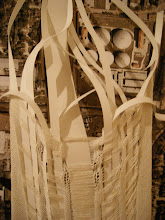Most highway interchanges systems, like the "T" crossing and the cloverleaf, were designed to provide uninterrupted speed and increased safety through simple grade separations and entry ramps. In 1935, landscape architect Charles Downing Lay proposed an usual merger of highway interchange and community. In Lay’s formulations, the limited-access highway was a protocol for recombining new and old roadways as well as means of appropriating land for different kinds of development. Given several separated lanes of traffic, direction could be assigned to each lane on an alternating basis according to traffic flow. Through independent alignments and the possible divergence of the two roadways, Lay also proposed to incorporate existing roadways and create parks within the irregular spaces between them. Exurban communities might also be site between separated roadways that were approximately a mile apart. The roadways would meet again for important bridges or intersections. The several hundred feet insulating the roadway would provide a kind of greenbelt around the small community.
“Switching intelligence became less important than optimizing larger networks of movement”


No comments:
Post a Comment